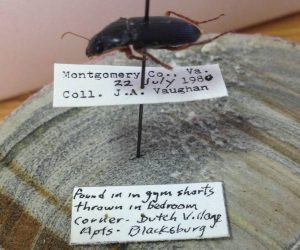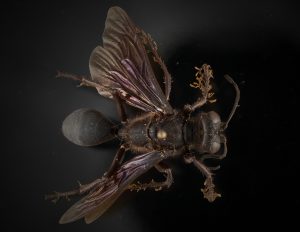We’ve been transferring our pinned insect specimens into new unit trays for several weeks now, an activity best described as time-consuming. When finished, we’ll have replaced our current mix of old, hard-bottomed and various types of soft-bottomed unit trays in VTEC with new, archival unit trays.
Pinned insects are so very fragile that it’s extremely easy to knock off a leg or other appendage unless you stay very focused on the task. When the specimens are in good shape and don’t require much additional work, then I might finish transferring all the specimens in five insect drawers by the end of the day. However, if the specimens aren’t already properly oriented on the pin, if the specimens are very small, if a leg drops off and I need to glue it to a card pinned under the label, if there’s a large mix of unidentified material that I need to sort to some crude taxonomic order…well, those are the really long days. So far I’ve come to dread insect drawers containing tipulids, phorids, syrphids, and or tettigoniids as working on them seems to take an eternity. And yesterday I accidentally jabbed a minuten pin holding a Culex sp. mosquito into my finger and was honestly surprised by the amount of blood this produced. (Even in death, mosquitoes are associated with blood loss.)
But one benefit to spending a lot of time looking at the specimens closely is that I see things that I might not have noticed with only a cursory glance in an insect drawer. For instance, I’ve found a number of specimens that I believe were collected by my thesis advisor when he was a student here at Virginia Tech in the 1960s. There isn’t anything particularly noteworthy about the material he deposited into the collection, but there’s a sense of history when you personally know the researcher who collected a particular insect 50 years ago.
In the category of “Overly honest collection information” we have this poor carabid beetle:
I also found a hackberry emperor butterfly (Asterocampa celtis) with a collection label that claimed the butterfly had “attacked the collector.” Hackberry butterflies are attracted to human sweat and are sometimes very enthusiastic about doing so. Unfortunately the specimen was so badly damaged by dermestid beetles that it was beyond saving.
And then there is this specimen of the katydid hunter Sphex pensylvanicus L.:
Notice the lighter-brown “sea-weedy” material on the tarsi? There’s a lot of it on the front legs (click on the photo for a larger image). We think these may be the thalli of a parasitic ascomycete fungus, possibly in the Order Laboulbeniales or a similar group. While some Laboulbeniales are associated with ants, I haven’t been able to find any published reports of these fungi on other Hymenoptera. These structures could be from a different type of ectoparasitic fungi or something else entirely, perhaps something new to science. Natural history collections are full of unrecognized species and hidden data waiting for someone to spot them, as described in this recent article from The Atlantic. I have no doubt that VTEC holds its share of hidden discoveries waiting for someone to bring them to light.
Sadly, I don’t have the time right now to investigate this specimen any further as our new insect cabinets have just arrived! Our immediate goal now is to arrange the collection into an updated phylogenetic order in the new cabinets. Sometimes curation is more about housekeeping than scientific research.
(Special thanks to Pat Shorter, an undergraduate member of the Marek Lab, for taking the photo of our infected Sphex wasp! She also took the photos of the Cissites auriculata beetle in our previous post.)



Pingback: Milkweed pollinia | Virginia Tech Insect Collection